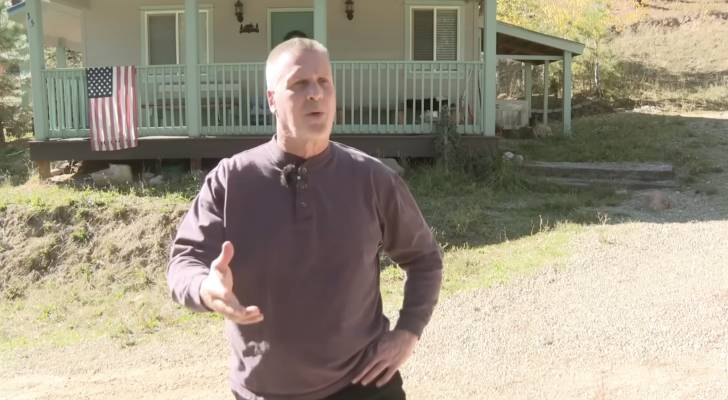
As wildfire risks intensify across the West, Idaho homeowners are facing an insurance crisis that’s leaving many residents without coverage or facing high premium hikes.
David Hoffman, 70, has lived in Garden Valley for a decade — long enough to know that fires come with the territory.
Must Read
- Thanks to Jeff Bezos, you can now become a landlord for as little as $100 — and no, you don’t have to deal with tenants or fix freezers. Here’s how
- Dave Ramsey warns nearly 50% of Americans are making 1 big Social Security mistake — here’s what it is and 3 simple steps to fix it ASAP
- Robert Kiyosaki says this 1 asset will surge 400% in a year — and he begs investors not to miss its ‘explosion’
"Fires here are a natural thing. You’re standing in the woods, look around," Hoffman told Idaho News 6. (1)
But this year, after one of the state’s most active fire seasons, his insurer dropped him.
“I’ve never had a claim. Why do you keep upping my insurance? You’re taking me out of my realm," Hoffman said. "We’re all being canceled.”
He’s far from the only one feeling priced out. A report from the Consumer Federation of America found that one in 13 U.S. homeowners are now forgoing home insurance altogether due to rising costs. (2)
For fire-prone communities like Garden Valley, that raises a burning question: how is this even allowed?
Rising risk, rising rates
Hoffman’s insurance company wasn’t the only provider tightening its coverage policies.
After receiving notice that his policy had been cancelled, he reached out to nearly 20 different insurance companies without success. Eventually, he found one willing to offer coverage, but at nearly twice his previous rate. Other homeowners are feeling the burn. Home insurance premiums have been climbing nationwide and show no signs of slowing down.
According to data from S&P Global Market Intelligence, homeowners saw an average 12% jump in premiums in 2023, followed by another 6.9% increase in the first half of 2024. (3)
Experts point to two major culprits: the growing cost of natural disasters and rising construction expenses. Hurricane Ida in 2021 and Hurricane Ian in 2022 together caused tens of billions in insured losses. Those two years alone, with combined insured losses of $220 billion, were the costliest for the industry in over a decade, according to the Insurance Information Institute. (4)
Even though Boise County has a strong record of protecting homes, Sheriff Scott Turner says his office regularly fields calls from residents looking for guidance after losing coverage or being priced out of their policies.
"I don’t really have an answer for these people because a lot of people are doing everything they can and it’s evidently still not enough," said Jordan Jones, Boise County’s wildfire mitigation administrator.
Read more: Robert Kiyosaki warns of a ‘Greater Depression’ coming to the US — with millions of Americans going poor. But he says these 2 ‘easy-money’ assets will bring in ‘great wealth’. How to get in now
Searching for coverage
Hoffman is now working with his mortgage company to find a solution. He’s also urging lawmakers to act, calling for stronger protections for what is often people’s largest financial asset: their homes.
If your insurer drops you or your rates suddenly skyrocket, you’re not powerless.
Smaller regional insurers or state-backed programs, often called FAIR (Fair Access to Insurance Requirements) plans, can sometimes offer last-resort coverage for homes in high-risk zones. (5)
You can also take steps to reduce your property’s risk profile. Updating your roof, clearing brush or adding ember-resistant vents can not only protect your home but also make you more attractive to insurers. Some companies even offer discounts for homeowners who take verified mitigation steps or install smart monitoring systems.
If premiums are still too steep, consider adjusting your deductible or bundling your home and auto coverage — it’s one of the simplest ways to lower costs without sacrificing protection. And don’t forget to ask about loyalty or claims-free discounts, especially if you’ve gone years without filing. Even if your current insurer isn’t canceling your policy, shopping around for better rates can sometimes save you hundreds of dollars each year.
"This is a big deal. Insurance companies need to stop being bullies and taking advantage of people financially,” Hoffman said.
What to read next
- Want to retire with an extra $1.3M? See how Dave Ramsey’s viral 7-step plan helps millions of Americans kill debt and build wealth — and how you can too
- I’m 49 years old and have nothing saved for retirement — what should I do? Don’t panic. Here are 6 of the easiest ways you can catch up (and fast)
- There’s still a 35% chance of a recession hitting the American economy this year — protect your retirement savings with these 5 essential money moves ASAP
- This tiny hot Costco item has skyrocketed 74% in price in under 2 years — but now the retail giant is restricting purchase. Here’s how to buy the coveted asset in bulk
Join 200,000+ readers and get Moneywise’s best stories and exclusive interviews first — clear insights curated and delivered weekly. Subscribe now.
Article sources
We rely only on vetted sources and credible third-party reporting. For details, see our editorial ethics and guidelines.
Idaho News 6 (1); Consumer Federation of America (2); S&P Global (3); Consumer Reports (4); Insurance Information Institute (5).
This article provides information only and should not be construed as advice. It is provided without warranty of any kind.